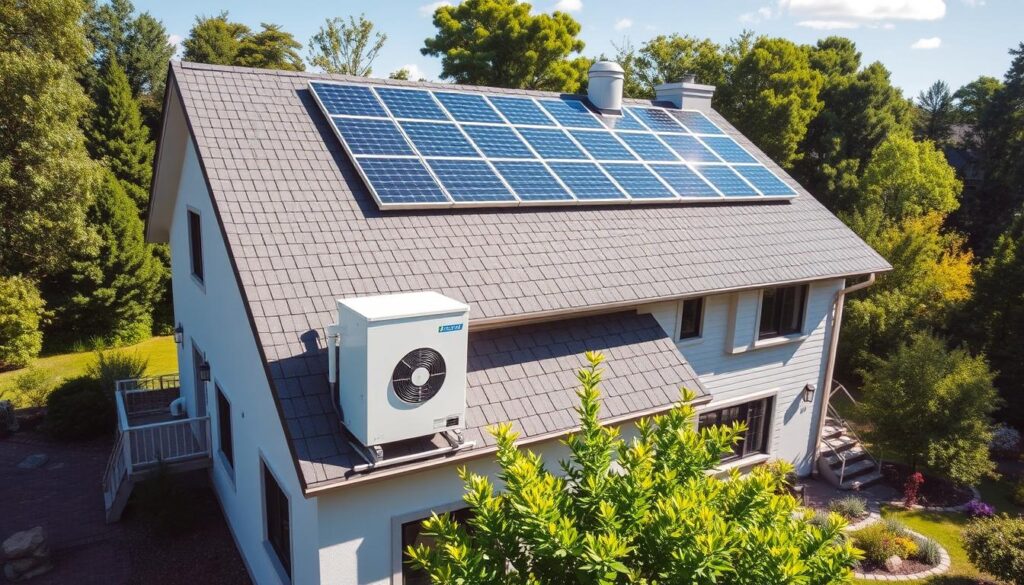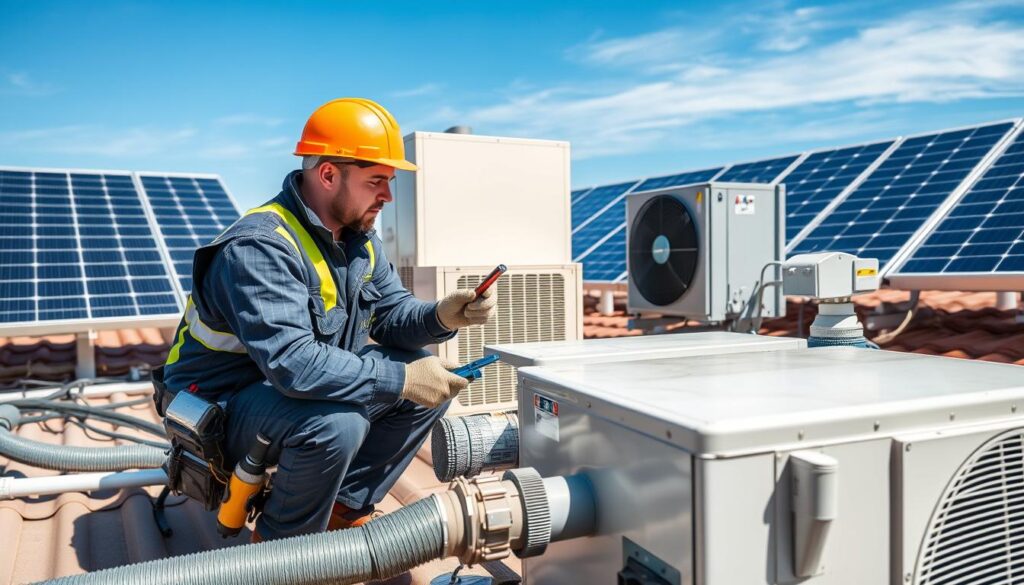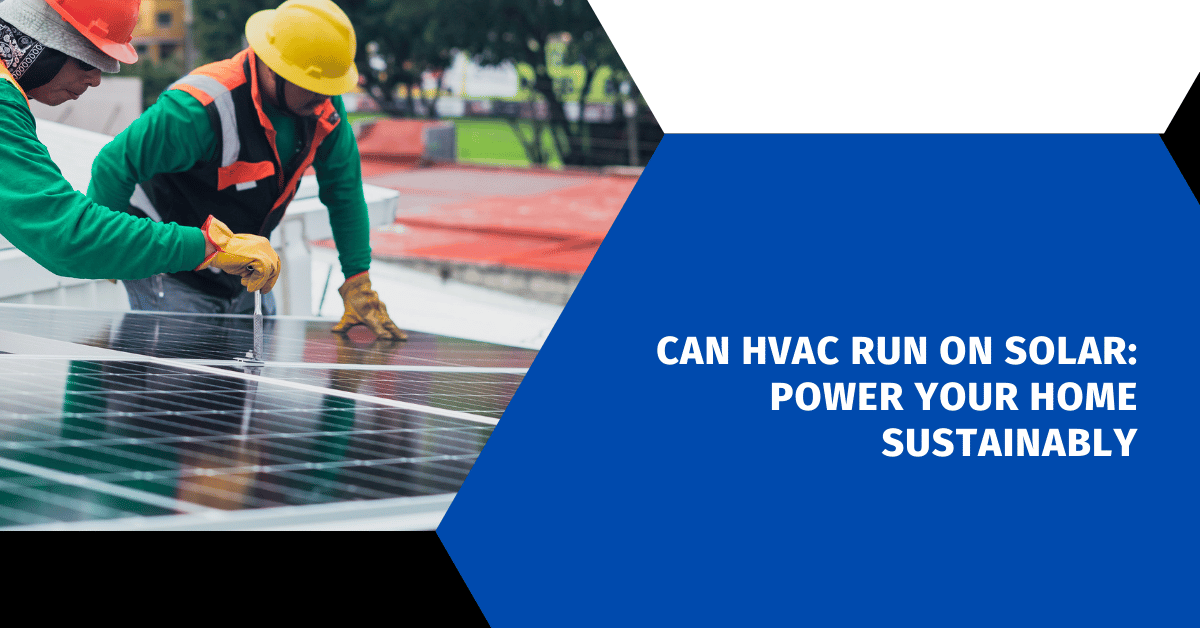Affiliate Disclosure
HVAC Guide Guys is a participant in the Amazon Services LLC Associates Program, an affiliate advertising program designed to provide a means for sites to earn advertising fees by advertising and linking to Amazon.
Can HVAC Run on Solar? Imagine a summer day with the sun shining bright on your home. Your air conditioning is running smoothly, all thanks to solar panels. This dream of solar-powered HVAC systems is now a reality for many homeowners.
Lisa and Michael, a young couple in sunny California, chose a solar-powered HVAC system. They’ve seen a big drop in their electricity bills. They also feel proud of reducing their carbon footprint. The team at Six Rivers Solar made the installation easy for them.
As people become more aware of the harm from traditional energy, sustainable cooling options like solar HVAC are gaining popularity. These systems are not just good for the planet. They also save money and give homeowners a sense of independence.

Key Takeaways:
- Solar-powered HVAC systems can effectively power your home’s air conditioning, reducing energy costs and environmental impact.
- Photovoltaic (PV) modules are capable of generating enough electricity to run air conditioning units for several hours.
- Integrating solar power with HVAC systems offers energy independence, lower operating costs, and increased property value.
- Understanding key HVAC ratings like BTU, tonnage, and EER/SEER is crucial for selecting the right solar-powered system for your home.
- The transition to sustainable cooling solutions like solar HVAC is driven by the growing demand for energy-efficient and environmentally-friendly home comfort systems.
Table of Contents
Understanding Solar-Powered HVAC Systems Basics
Homeowners and businesses are looking for green energy options. Solar power with HVAC systems is becoming more common. These systems use sunlight to make electricity for heating and cooling.
What is a Solar HVAC System?
A solar HVAC system mixes traditional HVAC with solar energy. It uses the sun’s power for heating, cooling, and sometimes hot water. The main parts are solar panels, inverters, and sometimes batteries for storing energy.
How Solar Panels Power HVAC Units
Solar panels turn sunlight into electricity. This electricity is then changed to the type used by HVAC systems. Solar panels can make enough power for 4-8 hours a day, depending on the sun.
Key Components of Solar HVAC Integration
- Photovoltaic (PV) panels: These solar panels convert sunlight into electrical energy.
- Inverters: Devices that convert the DC electricity generated by the PV panels into AC power usable by the HVAC system.
- Charge controllers: Regulate the flow of electricity from the PV panels to the battery storage system.
- Battery storage: Stores the generated solar energy for use when the sun is not shining.
With these parts, solar HVAC systems offer a green way to heat and cool. They cut down on energy costs and harm to the environment.
Explore Our HVAC Shop
Looking for top-rated HVAC tools, parts, and accessories? Visit our shop and find the perfect solution for your needs.
Visit the ShopCan HVAC Run on Solar: Essential Requirements
Running your HVAC system on solar power is a great, green choice. But, you need to size your system right for your energy use. To figure out how much solar power you need, calculate your daily energy use. Use the Seasonal Energy Efficiency Ratio (SEER) and how long your system runs.
A 1.5-ton air conditioner that runs for 8 hours a day uses about 6.3 kWh of electricity. If you live in a place with 4-6 peak sun hours, a 2kW solar system can power your AC during the day. It can also store energy for when the sun isn’t out.
When picking the right solar system size, think about your room size, AC unit tonnage, and how long you want it to run. This ensures your solar-powered HVAC meets your cooling or heating needs well. On average, a household AC unit uses 3,500 watts. A solar panel makes 250 watts. So, you’d need about 14 solar panels to power your HVAC system.
| Factors | Considerations |
|---|---|
| Room Size | Determine the right tonnage for your space for efficient cooling or heating. |
| AC Tonnage | Units with higher tonnage use more power, so you’ll need a bigger solar system. |
| Desired Runtime | Figure out your daily energy use based on how long you expect it to run. |
| Climate Impact | In hotter climates, you’ll need more power for air conditioning, affecting energy production needs. |
By thinking about these factors, you can make sure your solar-powered HVAC system is the right size. This way, it can meet your energy needs and keep your home cool or warm sustainably.
Types of HVAC Systems Compatible with Solar Power
Solar power can work well with many HVAC systems. This includes small window air conditioners and big central air setups. You can power your home’s climate control with solar energy, no matter the system type.
Window A/C Units and Solar Integration
Window air conditioners need a small solar panel array. They usually require 500-700 watts per hour. This makes them a good choice for those wanting to use solar power.
Split System Compatibility
Split air conditioning systems are also great with solar power. They have indoor and outdoor parts. These systems are quiet and easy to install, perfect for solar cooling.
Central Air Systems with Solar Power
Central air systems are good for big homes or businesses. They need more solar panels, about 1,200 watts per ton. This is because they handle more cooling.
Using solar power with your HVAC system can help the environment. It also saves money and makes you more energy independent.
Explore Our HVAC Shop
Looking for top-rated HVAC tools, parts, and accessories? Visit our shop and find the perfect solution for your needs.
Visit the ShopCalculating Solar Power Requirements for Your HVAC
When you think about using solar power for your HVAC, figuring out energy needs is key. Start by looking at your air conditioner’s energy use. This includes BTU/hr or kWh ratings, usage hours, and how often the compressor runs. Also, consider the Seasonal Energy Efficiency Ratio (SEER).
For instance, a 1.5-ton air conditioner that runs 8 hours a day and uses 6.3 kWh might need a 2kW PV system. This is if you live in a place with 4-6 peak sun hours. But, you should adjust these numbers based on your local solar index and how long you want it to run. Don’t forget about battery storage for nighttime use.
- Air conditioning accounts for 17% of total household electricity expenditure nationwide.
- Different types of solar air conditioners include AC solar air conditioners for off-grid systems, hybrid solar air conditioners, and DC solar air conditioners for on-grid systems.
- The power consumption of air conditioners typically ranges between 500 and 4000 watts.
To figure out how many solar panels you need for your HVAC, look at the unit’s power rating and energy efficiency. Also, think about how much sunlight your area gets. Usually, each ton of cooling capacity needs about 1,200 watts of solar panels for 4 peak-sun hours a day. By accurately calculating your energy use and solar panel output, you can make sure your HVAC system works well and uses solar power efficiently.

“An air conditioning unit typically pulls around 7A for every 1 ton of cooling capacity, but this figure varies with tonnage changes.”
Explore Our HVAC Shop
Looking for top-rated HVAC tools, parts, and accessories? Visit our shop and find the perfect solution for your needs.
Visit the ShopBenefits of Solar-Powered HVAC Systems
Switching to a solar-powered HVAC system can greatly benefit your home. You’ll see big savings on energy bills, a smaller carbon footprint, and more energy independence. These green cooling options change the game.
Cost Savings and ROI
Getting a new HVAC system can cut your utility costs by 40% to 50%, especially when it’s cold. Plus, homes with solar-powered HVACs sell for more because they’re energy-smart. The federal solar Investment Tax Credit (ITC) gives you a 30% tax credit for solar and HVAC combos, making it even more worth it.
Environmental Impact
Solar-powered HVACs cut down on traditional electricity use, leading to a big carbon footprint reduction. They use clean, renewable energy, making them eco-friendly. Keeping your solar panels and HVAC in good shape boosts their performance and life, helping the planet long-term.
Energy Independence
Solar-powered HVACs make you energy-independent by making your own electricity. This means big cost savings and protection from energy price swings. Battery storage keeps the power flowing even when it’s dark or during outages, making your system reliable and strong.
“Upgrading to a solar-powered HVAC system has been a game-changer for our home. We’ve seen a significant reduction in our energy bills and feel empowered by our ability to generate our own clean, renewable electricity.”
– Jane Doe, Homeowner
Battery Storage Solutions for Continuous Operation
Running your HVAC system on solar power needs battery storage for non-stop use. Systems like the Tesla Powerwall or Enphase help store extra solar energy. This stored energy powers your HVAC at night or during grid failures.
Battery storage is key for off-grid HVAC operation. It keeps your home’s temperature stable and efficient. Choose a battery size that matches your HVAC’s power needs and desired runtime.
| AC Unit Size | Solar Panel Requirements | Battery Storage Needs |
|---|---|---|
| 500-watt | 2-3 panels (250-300 watts each) | 4-5 batteries (150Ah each) |
| 1,000-watt | 4-5 panels (250-300 watts each) | 4-5 batteries (150Ah each) |
| 1,500-watt | 6-7 panels (250-300 watts each) | 4-5 batteries (150Ah each) |
| 2,000-watt | 8-9 panels (250-300 watts each) | 4-5 batteries (150Ah each) |
Adding solar batteries to your HVAC ensures it runs smoothly, even when it’s dark or the power’s out. This makes your home comfortable and sustainable.
Smart Integration and System Monitoring
Smart home technology is changing how we use solar-powered HVAC systems. It makes them more efficient and effective. Smart thermostats like Nest, Ecobee, or Honeywell work with your solar HVAC. They let you control your climate with ease.
These smart thermostats keep an eye on your solar energy. They adjust your HVAC to keep your home comfy. This way, you save energy and use less from the grid.
Solar HVAC Performance Monitoring
For the best results, you need tools to monitor your solar HVAC’s performance. Enphase MyEnlighten or the Tesla app give you all the details. They show how much energy your HVAC uses from the sun.
With this data, you can change your energy use. You can also make your solar system work better. This helps your home use less energy and save money in the long run.
Using smart home technology and solar monitoring tools is key. It lets homeowners control their energy use. They can also lower their carbon footprint and save money with a solar HVAC system.
Explore Our HVAC Shop
Looking for top-rated HVAC tools, parts, and accessories? Visit our shop and find the perfect solution for your needs.
Visit the ShopInstallation and Maintenance Considerations
Using a solar-powered HVAC system for your home is a smart choice. Professional installation and regular maintenance are key to its success. They ensure your system works well and lasts a long time.
Getting your system installed right is important. Experienced technicians will make sure it’s the right size and fits perfectly. They know how to connect your solar panels and HVAC unit correctly.
Keeping your system clean and doing regular checks is vital. This helps it run efficiently and live longer. Think about your roof, how much shade it gets, and local rules when setting up your system.
For the best outcome, pick a trusted company that knows solar and HVAC. They’ll guide you through the setup and teach you how to care for your system. This way, it will serve you well for many years.
- Ensure professional installation for proper system sizing and integration
- Prioritize regular maintenance to enhance efficiency and longevity
- Consider factors like roof condition, shading, and local regulations
- Partner with experienced providers in both solar and HVAC fields

“Proper installation and regular maintenance are the keys to unlocking the full potential of your solar-powered HVAC system. Investing in these critical steps will pay dividends in the long run.”
Financial Incentives and Tax Credits
Investing in solar-powered HVAC systems has its perks. There are many financial incentives and tax credits to help with the costs. Homeowners can use these to get the most out of their solar HVAC investment.
Federal Tax Credits
The federal solar Investment Tax Credit (ITC) gives a 30% credit on taxes for solar and HVAC systems. This can make your system more affordable, saving you thousands.
State-Specific Rebates
States also offer their own incentives and rebates for energy-efficient upgrades. For example, Florida gives a $150 rebate for high-efficiency air conditioning units. Check your state’s programs for more savings.
Utility Company Programs
Utility companies also offer incentives for energy-efficient HVAC systems, including solar. Contact your local provider to see what they offer. These can lower the cost of your system.
By using solar tax incentives, energy efficiency rebates, and the investment tax credit, you can make your solar HVAC system more affordable. Look into what’s available in your area to save on your home’s comfort and energy use.
Conclusion
Solar-powered HVAC systems are a smart choice for keeping your home cool. They use the sun’s energy to save you money and help the planet. As technology gets better, it’s easier and more affordable to use solar and HVAC together.
When looking into solar HVAC, think about size, battery storage, and smart tech. Talk to experts to find the best system for your home and area. This way, you can enjoy cool homes and save energy with the sun’s power.
The future of cooling homes is bright with solar power. It makes homes more independent and eco-friendly. By choosing solar, you help make homes cooler and greener for everyone.

